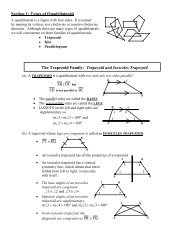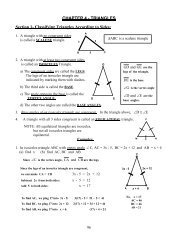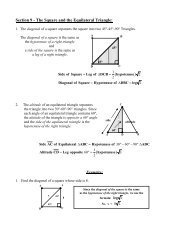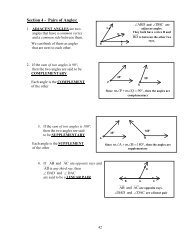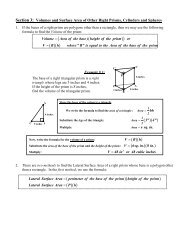Section 2: Summary – Properties of ... - Willets Geometry
Section 2: Summary – Properties of ... - Willets Geometry
Section 2: Summary – Properties of ... - Willets Geometry
Create successful ePaper yourself
Turn your PDF publications into a flip-book with our unique Google optimized e-Paper software.
<strong>Section</strong> 2: <strong>Summary</strong> <strong>–</strong> <strong>Properties</strong> <strong>of</strong> Quadrilaterals<br />
Kite<br />
Family<br />
Trapezoid<br />
Family<br />
Parallelogram<br />
Family<br />
Kite<br />
1. Diagonals are perpendicular<br />
2. Has 1 symmetry diagonal<br />
Special Kite:<br />
3. Diagonals are congruent to each other<br />
Trapezoid<br />
1. Parallel sides are called BASES<br />
2. Non-parallel sides are called LEGS<br />
3. IASSOTS on the left and right sides<br />
Isosceles Trapezoid<br />
4. Legs are congruent<br />
5. Diagonals are congruent<br />
6. Both pairs <strong>of</strong> base angles are congruent<br />
7. Opposite angles are supplementary<br />
8. Has 1 symmetry line<br />
Parallelograms<br />
1. Both pairs <strong>of</strong> opposite sides are parallel<br />
2. A diagonal separates it into two congruent triangles<br />
3. Both pairs <strong>of</strong> opposite sides are congruent<br />
4. Both pairs <strong>of</strong> opposite angles are congruent<br />
5. All 4 pairs <strong>of</strong> consecutive angles are supplementary<br />
6. Diagonals bisect each other.<br />
Rectangle:<br />
7. has 4 right angles (equiangular)<br />
8. Diagonals are congruent<br />
9. Has 2 symmetry lines<br />
Square:<br />
Has all 13 properties<br />
Rhombus:<br />
7. all 4 sides are congruent (equilateral)<br />
8. diagonals are perpendicular<br />
9. has 2 symmetry diagonals<br />
10. diagonals bisect the angles they connect
Note: Within the Parallelogram Family, there are “sub-families”<br />
Rectangle<br />
Family<br />
Rhombus<br />
Family<br />
Rectangle<br />
Square<br />
Square<br />
Rhombus
Quadrilaterals<br />
Trapezoid Isosceles Trapezoid<br />
Kite<br />
Special Kite<br />
Parallelogram Rectangle<br />
Rhombus<br />
Square
Assignment: <strong>Section</strong> 2<br />
Part 1: Refer to the quadrilaterals on page 140.<br />
Use a protractor and ruler as necessary to measure.<br />
1. Make a list <strong>of</strong> all quadrilaterals that are equilateral:<br />
2. Make a list <strong>of</strong> all parallelograms with congruent diagonals:<br />
3. Make a list <strong>of</strong> all quadrilaterals with perpendicular diagonals:<br />
4. Make a list <strong>of</strong> all equiangular quadrilaterals:<br />
5. Make a list <strong>of</strong> all parallelograms with perpendicular diagonals:<br />
6. Make a list <strong>of</strong> all quadrilaterals with at least one symmetry diagonal:<br />
7. Make a list <strong>of</strong> all quadrilaterals whose diagonals bisect each other:<br />
8. Make a list <strong>of</strong> all quadrilaterals with congruent diagonals:<br />
9. Make a list <strong>of</strong> all quadrilaterals with both pairs <strong>of</strong> opposite sides congruent:<br />
10. Make a list <strong>of</strong> all quadrilaterals with both pairs <strong>of</strong> opposite angles supplementary:<br />
11. Make a list <strong>of</strong> all quadrilaterals with all four pairs <strong>of</strong> consecutive angles supplementary:<br />
12. Make a list <strong>of</strong> all quadrilaterals with only one symmetry diagonal:<br />
13. Make a list <strong>of</strong> all parallelograms whose diagonals are congruent and perpendicular:<br />
14. Make a list <strong>of</strong> all quadrilaterals with both pairs <strong>of</strong> opposite angles congruent:<br />
15. Make a list <strong>of</strong> all quadrilaterals with all four pairs <strong>of</strong> consecutive angles congruent:<br />
16. Make a list <strong>of</strong> all quadrilaterals where both diagonals bisect the angles they connect:<br />
17. Make a list <strong>of</strong> any regular quadrilaterals:<br />
18. Make a list <strong>of</strong> all quadrilaterals whose diagonals are congruent and bisect each other:<br />
19. Make a list <strong>of</strong> all quadrilaterals with exactly one pair <strong>of</strong> opposite sides parallel
Part 2: Families <strong>of</strong> Quadrilaterals<br />
1. (a) The trapezoid and the isosceles trapezoid are members <strong>of</strong> the __________family.<br />
(b) The kite and the special kite are members <strong>of</strong> the __________ family.<br />
(c) The parallelogram, rectangle, rhombus and square are members <strong>of</strong><br />
the __________ family<br />
(d) The rectangle and the square are members <strong>of</strong> the ____________ family<br />
(e) The rhombus and the square are members <strong>of</strong> the ___________ family<br />
2. Determine which shapes have the given property and then fill in the blank<br />
with the FAMILY name:<br />
(a) If the diagonals <strong>of</strong> a quadrilateral bisect each other, then the quadrilateral must be a<br />
_______________<br />
(b) If the diagonals <strong>of</strong> a parallelogram are perpendicular, then the parallelogram must be a<br />
_______________<br />
(c) If the diagonals <strong>of</strong> a parallelogram are congruent, then the parallelogram must be a<br />
_______________.<br />
(d) If both pairs <strong>of</strong> opposite sides <strong>of</strong> a quadrilateral are parallel, then the quadrilateral<br />
must be a __________________.<br />
(e) If a quadrilateral is equiangular, then the quadrilateral must be a __________________<br />
(f) If a quadrilateral has both pairs <strong>of</strong> opposite angles congruent, then the quadrilateral<br />
must be a ________________<br />
(g) If a quadrilateral is equiangular, then the quadrilateral must be a __________<br />
(h) If the diagonals <strong>of</strong> a parallelogram are congruent and perpendicular, then the parallelogram must be<br />
a ___________<br />
(i) If a quadrilateral only has one symmetry diagonal, then the quadrilateral must be a __________<br />
(j) If a quadrilateral is regular, then it must be a ___________<br />
(k) If both pairs <strong>of</strong> opposite sides <strong>of</strong> a quadrilateral are congruent, then the<br />
quadrilateral must be a _____<br />
(l) If both pairs <strong>of</strong> opposite angles <strong>of</strong> a parallelogram are supplementary, then the parallelogram must<br />
be a _______<br />
(m) If exactly two sides <strong>of</strong> a quadrilateral are parallel and the diagonals are congruent, then the<br />
quadrilateral must be a(an) _______________________
Part 3- Name or sketch your answer to the following:<br />
1. Can you name a quadrilateral that is not a parallelogram?<br />
2. Can you name a quadrilateral, other than a rhombus, which has perpendicular diagonals?<br />
3. Can you name a quadrilateral whose diagonals bisect each other? Can you name more than one?<br />
What general name can you give to all the quadrilaterals whose diagonals bisect each other?<br />
4. Can you name a quadrilateral, other than a rectangle, where the diagonals are congruent?<br />
5. Can you name a quadrilateral, other than a square, where the diagonals are congruent and<br />
perpendicular?<br />
6. Can you name a parallelogram, other than a square, which has perpendicular diagonals?<br />
7. Can you name a parallelogram, other than a square, which has congruent diagonals?<br />
8. Can you name a parallelogram whose diagonals are both congruent and perpendicular?<br />
9. Can you name a parallelogram, other than a rectangle, rhombus or square, whose diagonals bisect<br />
each other?<br />
10. Can you name an equilateral quadrilateral, other than a square?<br />
11. Can you name an equiangular quadrilateral, other than a square?<br />
l2. Can you name a quadrilateral, other than a square, where the diagonals are perpendicular and bisect<br />
each other?<br />
l3. Can you name a parallelogram, other than a square, which contains at least one right angle?<br />
l4. Can you name a quadrilateral whose opposite sides are congruent?<br />
l5. Can you name a quadrilateral whose opposite sides are parallel? Can you name more than one?<br />
What general name can you give to all the quadrilaterals whose opposite sides are parallel?
Part 4: Decide whether each <strong>of</strong> the following clues describes the members <strong>of</strong> one specific family <strong>of</strong><br />
quadrilaterals. If the clue is not specific enough to guarantee membership in one particular family,<br />
then write “not enough information”<br />
1. Diagonals are perpendicular and has 1 symmetry diagonal.<br />
2. Exactly two sides are parallel<br />
3. Has 2 symmetry diagonals<br />
4. Exactly two sides are parallel and diagonals are congruent.<br />
5. Exactly two sides are parallel and both pairs <strong>of</strong> opposite angles are supplementary<br />
6. Both pairs <strong>of</strong> opposite sides are parallel<br />
7. Diagonals are congruent and has 1 symmetry diagonal.<br />
8. Equiangular quadrilateral<br />
9. Diagonals bisect each other and diagonals are congruent<br />
10. Quadrilateral with congruent diagonals<br />
11. An equilateral quadrilateral<br />
12. Quadrilateral with perpendicular diagonals<br />
13. Diagonals bisect each other and diagonals are congruent and diagonals are perpendicular<br />
14. Both pairs <strong>of</strong> opposite sides are parallel and diagonals are congruent<br />
15. Has 2 symmetry diagonals and 4 right angles<br />
16. Quadrilateral with congruent and perpendicular diagonals<br />
17. Both pairs <strong>of</strong> opposite angles are supplementary<br />
18. Parallelogram with perpendicular diagonals<br />
19. Equilateral and Equiangular<br />
20. All 4 pairs <strong>of</strong> consecutive angles are supplementary and diagonals are perpendicular<br />
21. Both pairs <strong>of</strong> opposite angles are congruent<br />
22. Has 4 right angles<br />
23. Both pairs <strong>of</strong> opposite sides are congruent and diagonals are perpendicular<br />
24. All 4 pairs <strong>of</strong> consecutive angles supplementary and congruent<br />
25. Diagonals bisect each other<br />
26. Both pairs <strong>of</strong> opposite sides are congruent and diagonals are congruent<br />
27. Both diagonals bisect the angles they connect<br />
28. Both pairs <strong>of</strong> opposite angles are congruent and diagonals are perpendicular
29. All 4 pairs <strong>of</strong> consecutive angles are supplementary<br />
30. Both pairs <strong>of</strong> opposite sides are parallel and diagonals are perpendicular<br />
31. Parallelogram with congruent diagonals<br />
32. Both pairs <strong>of</strong> opposite sides are congruent<br />
33. Parallelogram with congruent and perpendicular diagonals<br />
Part 5 <strong>–</strong> Review Questions<br />
1. A polygon with four sides is called a_________.<br />
2. If the diagonals <strong>of</strong> a quadrilateral bisect each other, then the quadrilateral must be a _____.<br />
3. If the diagonals <strong>of</strong> a parallelogram are congruent, then the parallelogram must be a ______.<br />
4. If the diagonals <strong>of</strong> a parallelogram are perpendicular, then the parallelogram must be a _____.<br />
5. If the diagonals <strong>of</strong> a parallelogram are congruent and perpendicular, then the parallelogram<br />
must be a ____.<br />
6. In any parallelogram, consecutive angles are ________.<br />
7. If the opposite angles <strong>of</strong> a parallelogram are supplementary, then the parallelogram<br />
must be a _______<br />
8. (TF) A parallelogram is a quadrilateral where both pairs <strong>of</strong> opposite sides are parallel.<br />
9. (TF) If the diagonals <strong>of</strong> a parallelogram are congruent and perpendicular, then the<br />
parallelogram is always a square.<br />
10. (TF) An equiangular, equilateral quadrilateral must be a square.<br />
11. (TF) If a quadrilateral is equilateral, then it must be a square.<br />
12. (TF) Every rhombus is equiangular.<br />
13. (TF) The diagonals <strong>of</strong> a trapezoid are always congruent.<br />
14. (TF) The diagonals <strong>of</strong> an isosceles trapezoid bisect each other.<br />
15. (TF) A square is a rhombus.<br />
16. (TF) If the diagonals <strong>of</strong> a parallelogram are congruent, then the parallelogram must be a<br />
rectangle.<br />
Fill in the blanks with “Always”, “Sometimes” or “Never”<br />
17. The opposite angles <strong>of</strong> a parallelogram are congruent.<br />
18. The opposite angles <strong>of</strong> a parallelogram are supplementary.<br />
19. The diagonals <strong>of</strong> a parallelogram are congruent.<br />
20. The diagonals <strong>of</strong> a rhombus are congruent.
21. The diagonals <strong>of</strong> a parallelogram are perpendicular.<br />
22. A parallelogram whose diagonals are congruent and perpendicular is a square.<br />
23. If the diagonals <strong>of</strong> a quadrilateral are perpendicular , then the quadrilateral is a<br />
rhombus.<br />
24. If the diagonals <strong>of</strong> a quadrilateral bisect each other, then the quadrilateral is a<br />
parallelogram.<br />
25. A parallelogram whose angles are congruent is a square.<br />
26. If two sides <strong>of</strong> a quadrilateral are parallel and the other two sides are congruent, then the quadrilateral is<br />
a parallelogram.<br />
27. The diagonals <strong>of</strong> a trapezoid are congruent.<br />
Multiple Choice:<br />
28. Which <strong>of</strong> the following statements is false?<br />
(a) a parallelogram is a quadrilateral<br />
(b) a rectangle is a square<br />
(c) a rectangle is a parallelogram<br />
29. If the diagonals <strong>of</strong> a quadrilateral bisect each other, then the quadrilateral is always a<br />
(a) rhombus (b) rectangle (c) parallelogram<br />
30. The diagonals <strong>of</strong> a kite always (a) bisect each other (b) are congruent (c) are perpendicular<br />
31. All quadrilaterals whose diagonals bisect each other are<br />
(a) rectangles (b) rhombi (c) parallelograms<br />
32. The diagonals <strong>of</strong> a rectangle are always (a) congruent and perpendicular<br />
(b) congruent and bisect each other (c) perpendicular and bisect each other.<br />
33. The consecutive angles <strong>of</strong> a parallelogram are always<br />
(a) right angles (b) supplementary (c) congruent<br />
34. The diagonals <strong>of</strong> a rectangle are always<br />
(a) congruent (b) bisectors <strong>of</strong> the angles they connect (c) perpendicular<br />
35. The opposite angles <strong>of</strong> a parallelogram are always<br />
(a) right angles (b) congruent (c) supplementary<br />
36. The diagonals <strong>of</strong> an isosceles trapezoid are always (a) congruent<br />
(b) perpendicular (c) bisectors <strong>of</strong> each other<br />
37. If the angles <strong>of</strong> a parallelogram are right angles then the parallelogram must be a<br />
(a) rhombus (b) rectangle (c) square



